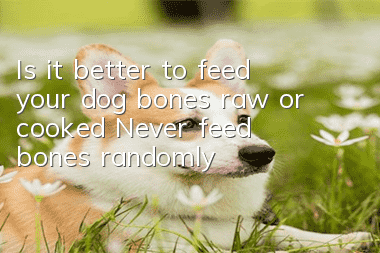Is it better to feed your dog bones raw or cooked? Never feed bones randomly!

The harm of cooked bones to dogs
Do not feed cooked bones, including some bone scraps. Cooked bones are easy to bite and have sharp edges. The following are the dangers of cooked bones
1. Damage to teeth
2. Damage to tongue and mouth
3. Ring around mandible The parietal bones will be damaged
4. Obstruction of the trachea, esophagus, and intestines
5. Constipation
6. Rectal hemorrhage
7. Peritonitis - caused by gastric or intestinal puncture Abdominal bacterial infection
Do not feed processed bones to dogs
In addition, there are some bone snacks bought in the market. These are usually processed and are not the same as the bones you buy at the market. Similar hazards may arise, causing dogs to become sick. For example, ham bones, tube bones, ribs, and joint bones. These products are smoked, baked and dried, and may contain preservatives, flavorings, and smoke agents. Dogs who eat these bones may suffer from the following symptoms:
1. Digestive tract blockage
2. Suffocation
3. Oral or tonsil damage
4. Vomiting
5 .Diarrhea
6. Rectal hemorrhage
7. Death (one case in eight dogs)
A similar situation can occur when chewing rawhide. These bones may have trace amounts of toxic chemicals left during the production process and may be contaminated with salmonella or E. coli. Chewing these items can cause digestive tract problems and blockages. Additionally, artificial dog chew bones may contain gelatin, artificial sweeteners, and other additives and preservatives that may be toxic or carcinogenic.
(The Healthiest Dog Bones)
Most unprocessed bones are edible for dogs. The softness and hardness of raw chicken, turkey, and beef bones are suitable for dogs to chew and digest.
Safety Guidelines for Feeding Dogs Bones
If you feed your dog bones, please follow the following rules:
1. Supervise your dog. You should not leave your dog alone to chew, as they may bite too hard, posing a risk of choking or oral injury.
2. Throw away the chewed bones. Chewed bones may have bone spurs. If you are not careful, they will damage the dog's mouth or esophagus. If the bones are too small, they may choke.
3. If your dog has dental problems or is recovering, please do not let him chew bones, as the above risks will be higher.
4. Do not chew bones, especially bone marrow, for dogs prone to pancreatitis. Bone marrow is high in fat, which can cause dizziness or diarrhea.
5. Don’t give bones to dogs that can bite them in half and swallow large pieces. You should know how dogs eat bones. They can swallow them and never chew them. In fact, this is not good.
6. Give bones after meals. A dog that's not too hungry probably won't just swallow the bone.
7. Don’t feed your dog a whole bone that can be swallowed.
8. Give your dog a bone that is longer than their mouth. That way they can't swallow it.
9. Do not feed your dog bones that have been cut lengthwise. For example, cutting leg bones may be more likely to split and create barbs.
10. Don’t feed your dog meat or ribs. These bones are likely to splinter.
11. Limit the time spent chewing bones and allow your dog to chew for 10 to 15 minutes at a time. Can reduce damage contribution.
2. Refrigerate unused bones. Throw them away after three to four days. Can reduce the possibility of bacterial contamination.
Chewing is a dog’s nature and an important leisure activity for dogs. Casual bones are like brushing and flossing. Lean bones break up tartar and reduce gum disease, cleaning teeth. Chewing also stimulates the production of salivary enzymes, which prevent plaque buildup.
Raw bones are a good source of calcium, phosphorus and other minerals. They have benefits for the digestive system, including strengthening stomach muscles, preventing bloating, promoting healthy bowel movements and preventing anal gland problems.
In addition to physical health, chewing can also stimulate a dog’s mental development. This can actually reduce anxiety, which has been linked to high blood pressure and heart disease.
As to whether the benefits of feeding dogs outweigh the risks, many veterinarians have different opinions on this issue. However, it is the dog owner who ultimately executes the decision. Some people advocate grinding the bones into a powder and sprinkling it on the food, which provides the minerals in the bones to the dog's diet without the risk of choking or other complications. However, this also circumvents the benefits of chewing. So when considering the pros and cons, you should do your homework or consult with a professional veterinarian before deciding to give your dog a bone.
- What do dogs eat to protect their stomach? It is important to protect their stomach and treat gastrointestinal diseases in dogs.
- How to tell if your dog is fat? Is your dog overweight?
- Will your dog catch a cold if you blow the air conditioner? What should you do if your dog catches a cold if you blow the air conditioner?
- What should you pay attention to when your dog drinks water? Don’t be careless when it comes to your dog’s drinking water.
- The dog's mouth bites and shakes. Why does the dog's mouth occasionally shake and bite?
- How to cut a dog's hair? Do you know how to cut a dog's hair correctly?
- Can dogs eat raw eggs? Why can’t dogs eat egg whites?
- Common Dog Problems in Summer How to Deal with Different Dog Problems
- How to keep dogs away from skin diseases. If you do this, will you see if your dog will still be infected with skin diseases?
- What causes anorexia in dogs? Dogs will become anorexic due to lack of exercise. Hounds run at least 5KM every day.



